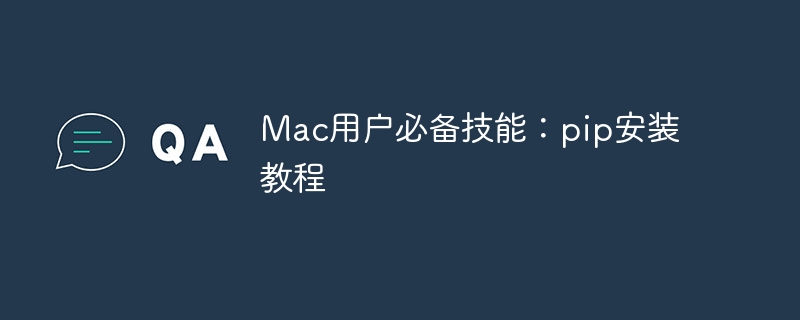Home >Backend Development >Python Tutorial >Essential skills for Mac users: pip installation guide
Essential skills for Mac users: pip installation guide
- WBOYWBOYWBOYWBOYWBOYWBOYWBOYWBOYWBOYWBOYWBOYWBOYWBOriginal
- 2024-01-17 09:28:061734browse

Essential skills for Mac users: pip installation tutorial, specific code examples are required
With the widespread application of Python and the continuous improvement of the development environment, pip is a Python package Management tools have become an essential skill for every Python developer. This article will introduce the pip installation method in detail for Mac users and provide specific code examples to help readers get started quickly.
1. Install pip
- Open the Terminal application.
- Enter the following command to download the get-pip.py file:
curl https://bootstrap.pypa.io/get-pip.py -o get-pip.py
- Enter the following command to install pip:
sudo python get-pip.py
Note: When entering this command, you will be asked to enter your Mac user password. After entering the password, press the Enter key.
- After the installation is completed, enter the following command to check whether pip is installed successfully:
pip --version
If the terminal outputs the version number of pip, it means that pip is installed successfully.
2. Use pip to install the package
After installing pip, we can use pip to install various Python packages.
Take installing the requests package as an example. The following is a specific code example:
- Open the Terminal application.
- Enter the following command to install the requests package using pip:
pip install requests
- After the installation is completed, enter the following command to verify whether the requests package is installed successfully:
python
- After entering Python interactive mode, enter the following command:
import requests
If no error is reported, it means that the requests package is installed successfully.
3. Use pip to install the specified version of the package
Sometimes, we need to install the specified version of the Python package. pip can specify the version of a package to install by adding a version number.
The following is a specific code example:
- Open the Terminal application.
- Enter the following command to use pip to install the specified version of the flask package (for example, version 2.0.0):
pip install flask==2.0.0
- After the installation is completed, enter the following command to verify flask Whether the package is installed successfully:
python
- After entering Python interactive mode, enter the following command:
import flask
If no error is reported, it means that the flask package is installed successfully.
4. Use pip to update packages
Pip can not only be used to install new packages, but also to update installed packages.
The following is a specific code example:
- Open the Terminal application.
- Enter the following command to update the flask package to the latest version using pip:
pip install --upgrade flask
- After the update is completed, enter the following command to verify whether the flask package is updated successfully:
python
- After entering Python interactive mode, enter the following command:
import flask
If no error is reported and the updated version number is output, it means that the flask package is updated successfully.
Summary:
This article introduces in detail how Mac users install pip, and provides specific code examples to help readers understand the basic usage of pip and the steps to install and upgrade packages. By studying this article, I believe that you have mastered the basic skills of using pip, can easily develop Python in a Mac environment, and have a deeper understanding and application of Python's rich ecosystem.
The above is the detailed content of Essential skills for Mac users: pip installation guide. For more information, please follow other related articles on the PHP Chinese website!

